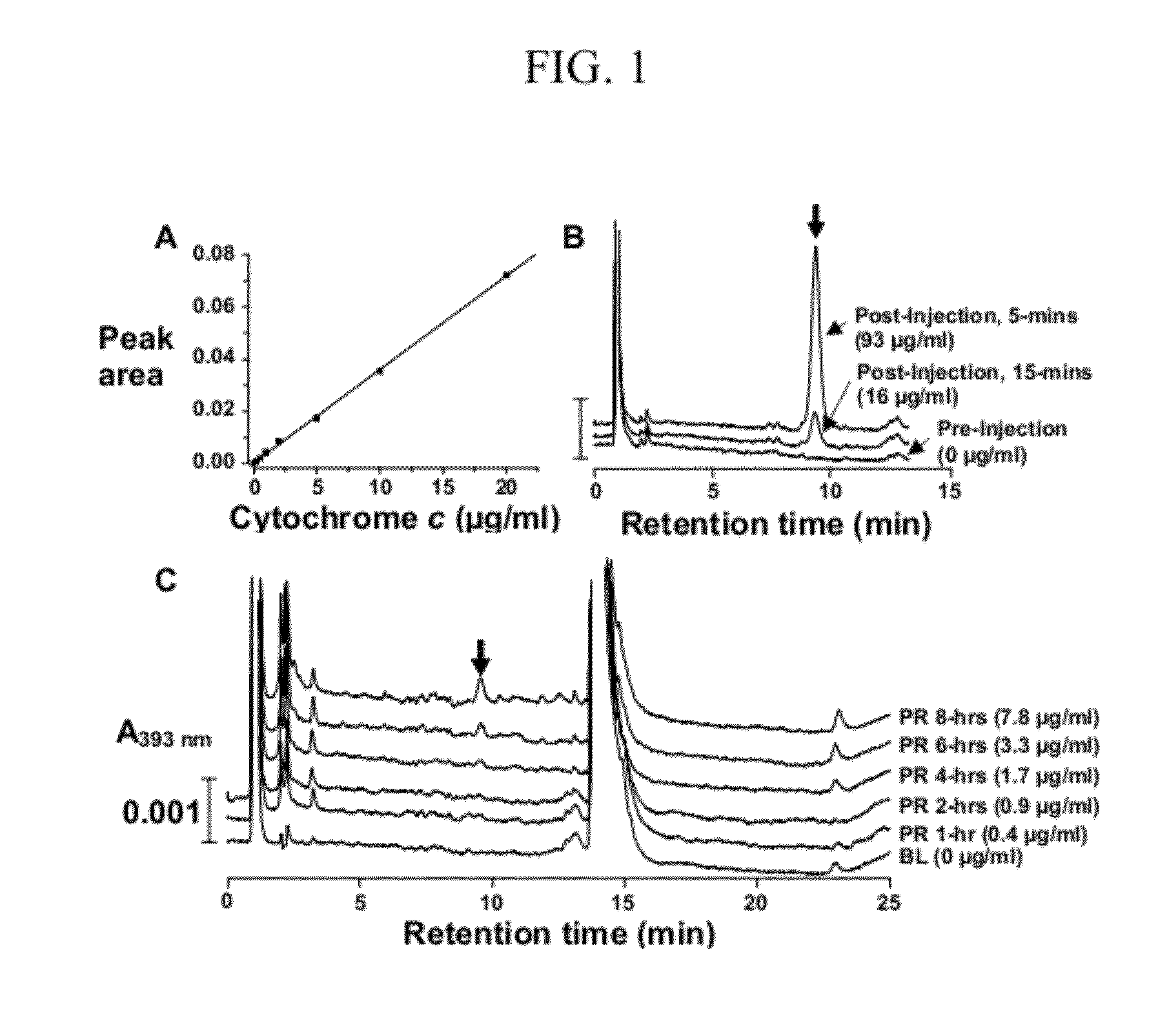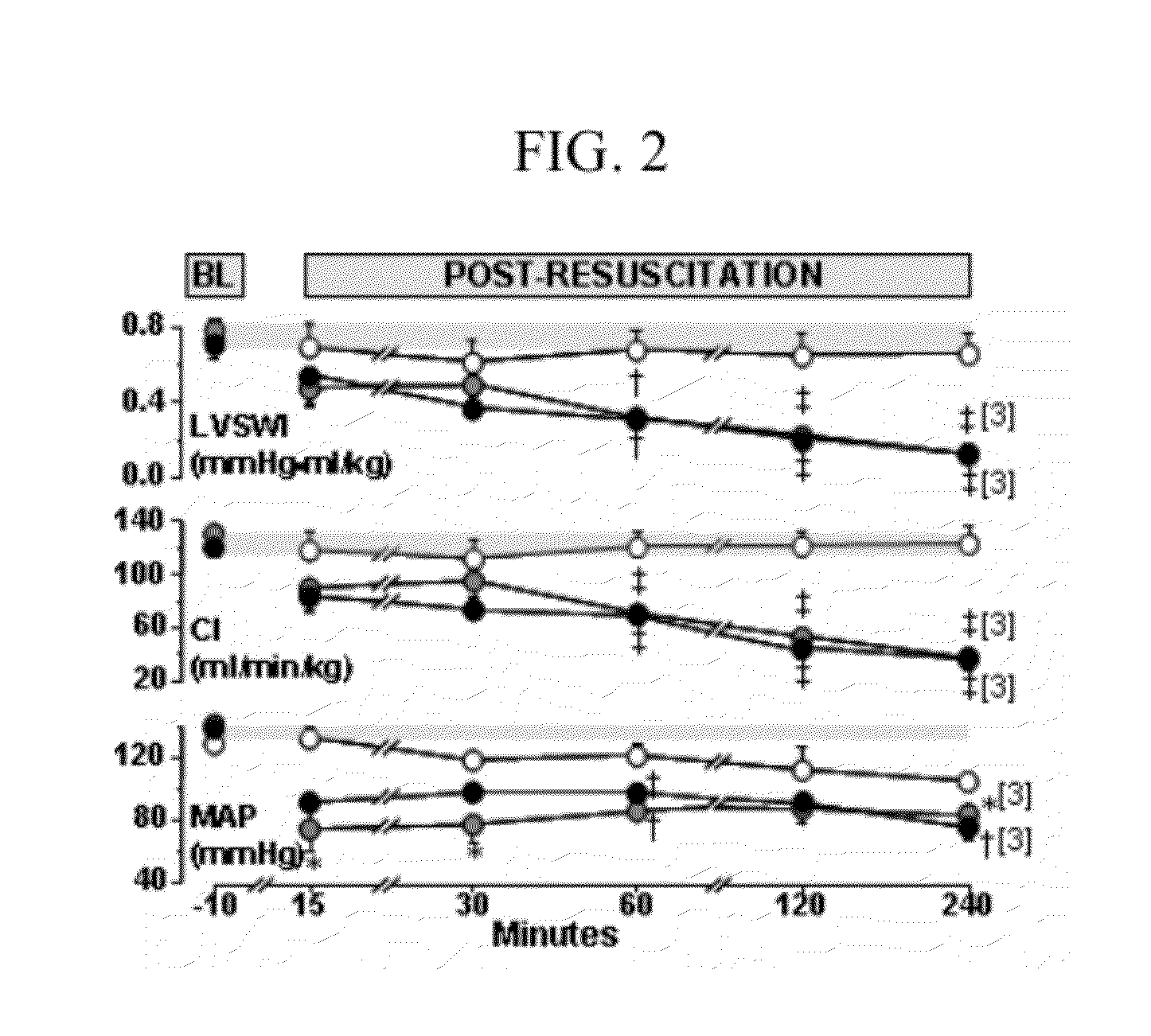Circulating cytochrome c as biomarker of reperfusion injury and responsiveness to mitochondrial targeted interventions
- Summary
- Abstract
- Description
- Claims
- Application Information
AI Technical Summary
Benefits of technology
Problems solved by technology
Method used
Image
Examples
example 1
Animal Preparation for VF and Resuscitation Protocol
[0029]Adult male Sprague-Dawley rats (480 to 550 g) were anesthetized using sodium pentobarbital (45 mg / kg intraperitoneal for induction and 10 mg / kg intravenous every 30 minutes for maintenance). A 5-F cannula was orally advanced into the trachea and used for positive pressure ventilation during cardiac resuscitation and the post-resuscitation interval. Proper placement was verified using an infrared CO2 analyzer (CO2SMO model 7100, Novametrix Medical Systems, Inc.). A conventional lead II ECG was recorded through subcutaneous needles. PE50 catheters were advanced through the right femoral vein into the right atrium, from the right carotid into the left ventricle, and from the left femoral artery into the abdominal aorta for pressure measurement and blood sampling. A thermocouple microprobe (IT-18, Physitemp) was advanced through the right femoral artery into the thoracic aorta for thermodilution cardiac output measurement. A PE50...
example 2
Hemodynamic Variables
[0031]Continuous physiological measurements were transduced, conditioned (BIOPAC Systems), and digitized at 250 scans per second using a 16-bit data acquisition board (AT-MIO-16XE-50; National Instruments). Systemic and left ventricular pressures were obtained through fluid-filled systems attached to disposable pressure-transducers (Maxxim Medical) zeroed to midchest level. Cardiac output was measured by thermodilution after right atrial bolus injection of 200 μl of 0.9% NaCl at room temperature and curve-analysis using custom-developed LabVIEW-based software. Cardiac index (CI) was calculated by normalizing cardiac output in ml / min to body weight in kilograms. The stroke volume index (SVI) was calculated by dividing cardiac index by heart rate. Left ventricular stroke work index (LVSWI) was calculated by multiplying the SVI by the difference between left ventricular systolic and diastolic pressures.
example 3
Measurement of Plasma Cytochrome c
[0032]Arterial blood samples (200 μl) were collected into heparinized syringes and centrifuged at 5,000 rpm (2,320 g) for 10 minutes at 4° C. The supernatant (plasma) was frozen at −80° C. for differed analysis using reverse-phase high performance liquid chromatography (HPLC) and western immunoblotting in series-1 but used immediately for analysis by HPLC in series-2.
[0033]HPLC: A reverse-phase HPLC technique previously used to measure cytochrome c in mitochondrial suspension and cytosol was adapted for measuring cytochrome c in plasma. Samples were first treated with 50% acetonitrile solution containing 0.1% trifluoro-acetic acid (ACN-TFA) (1:1, V / V) and then centrifuged at 5,000 rpm (2,320 g) for 10 minutes to precipitate plasma proteins of high molecular weight. Cytochrome c was measured in the supernatant using a Beckman HPLC System equipped with a Jupiter C4 reverse-phase analytical column (150×4.6 mm, 5 μm, Phenomenex) preceded by a guard colu...
PUM
| Property | Measurement | Unit |
|---|---|---|
| Vapor pressure | aaaaa | aaaaa |
| Vapor pressure | aaaaa | aaaaa |
Abstract
Description
Claims
Application Information
 Login to View More
Login to View More - R&D
- Intellectual Property
- Life Sciences
- Materials
- Tech Scout
- Unparalleled Data Quality
- Higher Quality Content
- 60% Fewer Hallucinations
Browse by: Latest US Patents, China's latest patents, Technical Efficacy Thesaurus, Application Domain, Technology Topic, Popular Technical Reports.
© 2025 PatSnap. All rights reserved.Legal|Privacy policy|Modern Slavery Act Transparency Statement|Sitemap|About US| Contact US: help@patsnap.com



